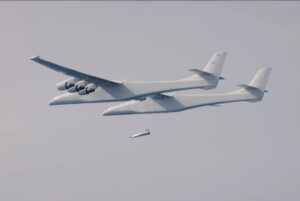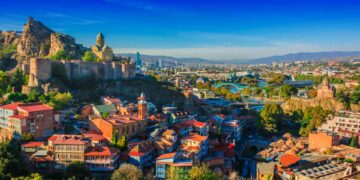
Chalk up another milestone for Stratolaunch, the air-launch venture created by the late Microsoft co-founder Paul Allen: The company’s mammoth airplane deployed a winged test vehicle for its first rocket-powered flight.
Stratolaunch’s single-use TA-1 test vehicle blazed a trail for future reusable hypersonic test vehicles that are expected to help the U.S. military catch up on one of the frontiers of aerial combat. TA-1 went supersonic, according to Zachary Krevor, Stratolaunch’s president and CEO — but based on his comments, it may not have quite hit the hypersonic standard of five times the speed of sound.
“While I can’t share the specific altitude and speed TA-1 reached due to proprietary agreements with our customers, we are pleased to share that in addition to meeting all primary and customer objectives of the flight, we reached high supersonic speeds approaching Mach 5 and collected a great amount of data at an incredible value to our customers,” Krevor said in a news release.

Today’s test flight took place in the skies above California’s Mojave Air and Space Port, where Stratolaunch keeps its twin-fuselage Roc airplane. Roc is the world’s biggest operational aircraft, with a wingspan of 385 feet. It’s designed to serve as a flying launch pad for rocket-powered vehicles like the TA-1 and its successors.
The air-launch concept makes it possible for launch missions to be flown from any airport with a runway that’s big enough to accommodate Roc. It’s similar to the concept that was used back in 2004 to win the $10 million Ansari X Prize for private spaceflight with financial backing from Paul Allen.
Allen founded Stratolaunch in 2011, and at one time planned to use the company’s air-launch system to send crewed space planes into orbit. After Allen’s death in 2018, Cerberus Capital Management acquired Stratolaunch, shifted its business HQ from Seattle to Mojave, and shifted its focus to hypersonic vehicles.
Roc made its first test flight in 2019, and for the past few years, Stratolaunch has been taking a step-by-step approach in preparation for today’s first powered flight of an air-launched test vehicle. The mission profile typically calls for the vehicle to be carried beneath Roc at takeoff, and released for launch at an altitude in excess of 20,000 feet.
This flight was the 14th test mission for Roc, coming after an unpowered separation test of its TA-0 vehicle and two captive-carry test flights for TA-1. Today’s test also marked the first in-flight use of Ursa Major’s Hadley rocket engine. The primary test objectives included a safe release of TA-1, engine ignition, acceleration, sustained climb in altitude and a controlled splashdown into the Pacific.
“Our goal with this flight was to continue our risk reduction approach for TA-2’s first reusable flight and be steadfast on our commitment of delivering maximum value to our customers,” Krevor said. “We are excited to review the data from today’s test and use it as we plan our next steps toward TA-2’s first flight later this year.”
In 2022, the U.S. Air Force Research Laboratory struck a deal with Stratolaunch to support TA-1’s flight test. Financial terms of the contract weren’t announced.
The U.S. military is expected to use data from Stratolaunch’s flight tests to develop hypersonic weapons systems as well as countermeasures. For years, Pentagon officials have voiced concern over the development of hypersonic weapons by Russia and China. Russia has already used air-launched, hypersonic Kinzhal missiles in its war against Ukraine.
Stratolaunch is currently building TA-3, the second fully reusable hypersonic test vehicle in its Talon-A product line. It’s also beginning modifications to the Spirit of Mojave, a customized Boeing 747-400 that was acquired last year from Virgin Orbit during that company’s bankruptcy proceedings. The Spirit of Mojave will become Stratolaunch’s second air-launch platform.















































